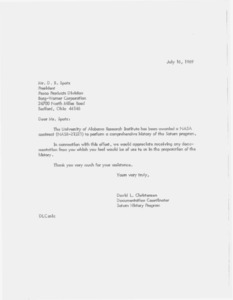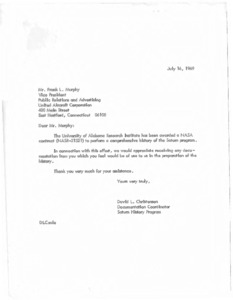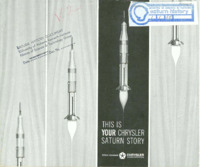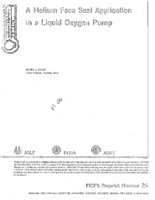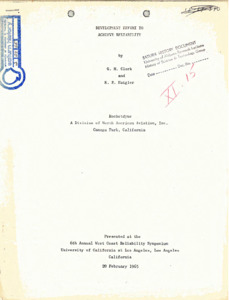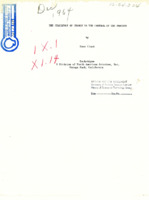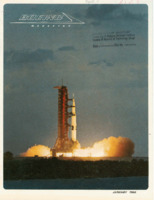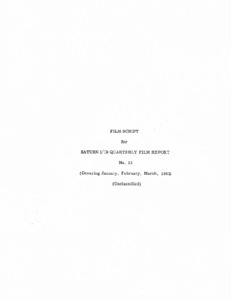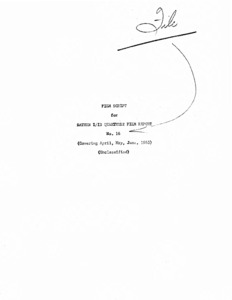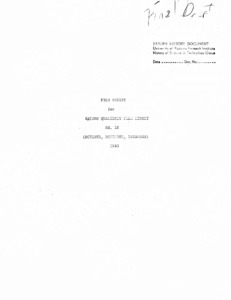
Browse Items (970 total)
Sort by:
-
"Letter to Mr. D. R. Spotz."
Letter to D. R. Spotz from David L. Christensen informing an awarding of a contract as well sa requesting documents. -
Letter to Mr. Frank L. Murphy.
Letter to Frank L. Murphy from David L. Christensen informing of an awarded contract. Also requests documents. -
"This is Your Chrysler Saturn Story."
The document is a booklet created as part of the NASA/Chrysler Corporation Space Division manned flight awareness program. It discusses Chrysler's role in manufacturing and testing the Saturn and includes photographs and diagrams of Saturn stages, operations at Michoud, testing, and future missions. The section headings included in this booklet are "Chrysler and the Saturn," "Saturn at Michoud," "The Voyage of Saturn," "Saturn Firings," and "Saturn's Missions." -
"A Helium Face Seal Application In a Liquid Oxygen Pump."
Presented at the Fourth International Conference on Fluid Sealing held in conjunction with the 24th annual meeting in Philadelphia, May 5-9, 1969. -
"Development Effort to Achieve Reliability."
Presented at the 6th West Coast Reliability Symposium, University of California at Los Angeles, Los Angeles, California, 20 February 1965.The development of a large liquid rocket engine can represent the expenditure of several hundred million dollars of effort. Before 30 percent of the contracted development funds have been expended, however, the engine will probably have operated for the mission duration. The capability to operate at least one successful test early in a development program is evidence of achieving a minimal reliability level, but the major objective of the development program is producing a design which performs reliably. A rocket engine reliability prediction must view reliability as a dynamic concept, constantly being altered by development effort. -
"The Challenge of Change vs the Control of the Process."
The introduction states, "This paper is designed to present the Rocketdyne engine program as it applies to the Saturn launch vehicles and will apply to the Apollo program of manned flight to the moon (Fig. 1). The vehicle that will launch this flight is the Saturn V, the largest and most powerful of the Saturn family. This vehicle, 362 feet tall and 33 feet in diameter, will be capable of sending a 45-ton payload to the moon or placing a 120-ton payload in earth orbit. Five F-1 engines power the first stage of the Saturn V; five J-2 engines, the second stage; and one J-2 engine, the third stage. The thrust of the first-stage engines alone will be equivalent to 160 million horsepower. Both of these engines, the F-1 and the J-2, were designed at, and are currently being produced by Rocketdyne." -
Boeing Magazine, vol. XXXVIII, no. 1, January 1968.
The magazine includes the articles "'A Pleasure to Our Eyes'", "New Paint Job", "Six-year Gasp", "Wings on the Nose", "How is SRAM Doing", "Flying Carpet", "A Citizen's Debt", and "Investment in Bonds". Also included is a briefing of events in the Boeing Company. -
"Film script for Saturn I/IB quarterly film report no. 15."
Unclassified film script of the Saturn I/IB Quarterly Film Report covering January, February, March, 1963. There are handwritten notes and edits throughout the document. -
"Film script for Saturn I/IB quarterly film report no. 16."
Unclassified film script of the Saturn I/IB Quarterly Film Report covering April, May, June, 1963. There are handwritten notes and edits throughout the document. -
"Film script for Saturn quarterly film report no. 18."
Unclassified film script of the Saturn I/IB Quarterly Film Report covering October, November, December, 1963. A handwritten note at the top of the title page lables this copy as the "Final Draft".
